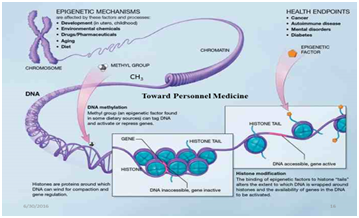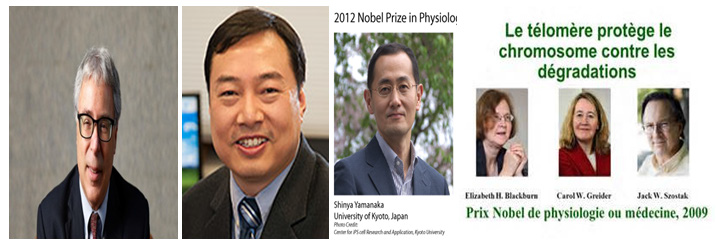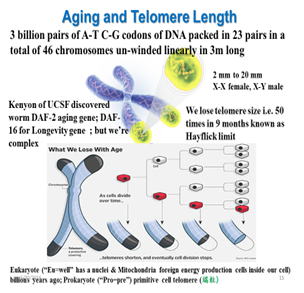MOJ
eISSN: 2576-4519


Review Article Volume 1 Issue 4
Department of Biomedical Engineering, The Catholic University, USA
Correspondence: Harold Szu, Department of Biomedical Engineering, The Catholic University, Wash DC, USA
Received: October 29, 2017 | Published: November 10, 2017
Citation: Szu H. Hacking the code for reverse-aging. MOJ App Bio Biomech. 2017;1(4):127–132. DOI: 10.15406/mojabb.2017.01.00020
Scientists of Prof. Cai's Lab of Albert Einstein Medical College in N.Y.N.Y. have broken the code of reverse aging of lab mice. They have identified micro-RNA generated from Hypothalamus stem cells can reverse the aging of lab mouse. At this critical junction, we need to do the same to large scale human subjects following the NIH Gold Standard. Instead of relying on Venture Capitalists (VC) investment, a large amount of federal public funding may be required to maintain the neutrality of the knowledge for Homosapiens.
World War II Baby-Boomers are getting old about 40 millions of them. They are facing aging-related disorders: e.g. Type-II Diabetics, Heart Attacks, and Strokes as well as some forms of Cancers. Nevertheless, their experience and judgment is a terrible things to be wasted. Scientists at Google, CALICO (CA Life Co), National Institute of Aging (NIA; HHS/NIH) all believe that mankind is on the brink to be, so-to-speak, rocketed to, besides the moon, the “immortality promising land,” in a sufficient escape velocity. This is microscopically hacking the code of reverse aging at the cellular level. Besides the Nobel, the Kyoto, the Templeton Prizes, there is a dedicated foundation initiated by Dr. Joon Yun, who is personally sponsoring the $ million Palo Alto Longevity Prize through the private foundation Palo Alto Institute. It is a life science competition dedicated to ending aging, since Sept 9, 2004, Longevity Demonstration Prize ends September 9, 2018 to hack the code of life and cure aging. (Parts in Homeostasis, hearts beats etc. & Parts in Longevity Demonstration). Time Magazine has featured that babies of the Year born after 2015 can live 142 years old all the way to 2157, (Figure 1). The 2009 Nobel Laureates in Physiology & Medicine, Prof. Katherine Blackburn at UC Berkeley & Carol W. Greider (former Ph D Student) and Dr. Jack W. Szostak (Harvard) discovered the telomerase enzyme has an intrinsic clock of L. Hayflick (1965) 50 turns, before the Apoptosis gene is set into a programming death. Moreover, the 2012 Nobel Laureate in Physiology & Medicine Dr. Shinya Yamanake of UCSF and now at Kyoto has identified 4 specific genes called induced Pluripotent Stem (iPS) named by him which can rewind back the Clock at the embryonic state. Recently, Dr. Dengsheng Cai of Albert Einstein Medical College (AEMC) has cracked the code of reverse aging--- "It's all in your head, and the secrete lies in the micro-RNA in the Hypothalamus that has been known to control the metabolism of the time clock, growth maturity.
The micro-RNA (miRNA) is a short, non-coding RNA, It is not the messenger-RNA (mRNA) for DNA synthesis; rather, the miDNA prevents mRNAs synthesis into DNA, by binding on mRNA to reproduce aged protein. This fact has been done in the NIH Gold Standard fashion (Double Blind (DB), Negative Control (NC) & Sufficient Statistics (SS)) to the lab mice successively; human subject studies are desperately needed. At this junction of promising cross road, we need to usher in unprecedented multidisciplinary research on the Homosapiens. We plead to the federal agency $B funding to conduct large-scale human studies that will be overseen by HHS/NIH with the Gold Standard (DB, NC,SS). The federally funded work without being limited by private investment IP Right Restriction, e.g. Silicon Valley VC, so that to live longer become a basic human right rather only for affordable rich people.
From the irreversible thermodynamics point of view, the incessant inter-molecular collision mixing will increase the "degree of uniformity," measured by the Boltzmann Entropy S, leading to the heat death.
However, the irreversible thermodynamics heat death did not prevent an open dynamic system to rejuvenate itself. For example, one can shuffle uniformly covered snow, at a maximum entropy, out of highway to make the highway passable.
In order to help the public to influence the congressional representatives, the general public needs to be educated about the reverse aging phenomenology. Herewith, we provide the necessary basics. We begin with the evolution of our ancestor at singe cells level which have hijacked the Mitochondria bacterial as the power house based on Adenosine triphosphate (ATP) to become multiple cell organisms to achieve survival functionality.
Symbiotic evolution partner mitochondria bacterial as efficient power house
Our multiple cells have evolved billions of years from molecular level by taking into account the molecular cellular dynamics, due to our power house co-evolution partner: Mitochondria bacteria's (Figure 1A) (Figure 1B). Then, single cells become possible in the ocean environment to hijack other single cells Mitochondria (Mt) bacteria's to aggregate into a cluster in 3D structure. The Mitochondria has its own DNA in the circular genomes that were engulfed during metazoans period by the early ancestors of today's eukaryotic cells. Human mtDNA is inherited from the mother, as an egg contains on average 200,000 mtDNA molecules, whereas a healthy human sperm was reported to contain on average 5 mtDNA molecules. In most multi-cellular organisms, the mtDNA – or Mitogenome – is organized as a circular, covalently closed, double-stranded DNA. Each can provide a much higher ATP energy production, so that a cluster of multiple cells becomes possible to achieve different survival functionality. Eventually, the organism migrated to land and paddling fins became leggy animals.
Genome versus phenome, namely DNA versus epigenetic( methylation & histone)
What is gene DNA?
Figure 2 Nobel Laureates Crick & Watson determined the double helix of DeoxyriboNucleic Acid (DNA) which is a macro-molecule made of different repetition of alternating sugar-phosphate backbone: A(Adenine)-T(Thymine) & C(Cytosine)-G(Guanine) pairs (in hydrogen-co-valance-bound). Human has 3 billion pairs of A-T C-G codons of DNA packed in 23 pairs in a total of 46 chromosomes un-winded linearly in 3m long.


Figure 2
What is Epigenetics (Greek: outside)?
The epigenetic phoneme typing is mediated by the Methylation (CH3) biomarkers, and Histone Spooling of gene-expression or gene-suppression. Epic (Greek: Outside) Genetics that is Phoneme environmental control of Genome through the biomarker CH3 Methylation as Histone spooling to make segments of genes expressive revealing or suppressive hidden.
What is the micro-RNA?
It is a short non-coding RNA that regulates human genes and binding messenger-RNA prevents their translation into proteins, e.g. aged protein (Figure 3). The reverse aging has been investigated in human by Dr. Nir Barzilai of Albert Einstein College of Medicine (AECM) by the Bronx, New York conducted a double blind control study beginning in 2015 of roughly 3000 elderly people; half would get a placebo and half would get an old (indeed, ancient) drug for type 2 diabetes called Metformin, which has been shown to modify aging in some animal studies.

Figure 3
Microscopically, Dr. Dengsheng Cai studied aging from AECM Molecular Pharmaceutical Researchers on Reverse Aging in mice with stem cells1 (VOA's Kevin Enochs reports, August 13, 2017). Dr. Dongsheng Cai from the Molecular Pharmacology of AECM has invigorated mice in an area of the brain called the Hypothalamus which is known to control the growth & reproduction metabolism of mice and published in Nature Magazine. He conducted a Gold Standard Control Study (Double-Blind, Negative Control, Sufficient Statistics) Stem cells of micro-RNA that inhibitory to certain protein formation the Hypothalamus setting the body's clock:
Dr. Dongsheng Cai from the Molecular Pharmacology of AECM in New York has invigorated mice in an area of the brain called the Hypothalamus which is known to control the growth & reproduction metabolism of mice and published in Science Magazine. He conducted Gold Standard Control Study Stem cells of the Hypothalamus setting the body's metabolic clock (Figure 4).

Figure 4


Figure 5
Shinya Yamanaka discovery that adult somatic cells can be reprogrammed into Pluripotent cells has had a profound effect on developmental and stem cell biology. By introducing the genes for four factors that turn genes on and off, he induced the skin cells of adult mice to become like embryonic stem cells. He focuses on ways to generate cells resembling embryonic stem cells by reprogramming somatic, or skin, cells to 4 induced Pluripotent Stem (iPS) Genes of mice & human (Figure 5).
DNA is like a hardware of computer language that carries most of the genetic instructions used in the growth, development, functioning, and reproduction of all known living organisms and many viruses. This is similar to genome & phoneme (genetic DNA likes machine language hardware; epigenetic is like a programming software). While Human Genome Program studied the hardware, European Epigenetic Programs studied the software. We have investigated many identical twins that their lifestyles may have influenced the Epigenetics that pass down to influence the next gen. We understand the disorder and the longevity better. Stem cells of microRNAs can set the Hypothalamus, mice's clock reversing the aging, which remains to be demonstrated for a human with no string attached federal funding. "In God We Trust, All the Rest Show Data". A common sense of keeping the longevity of 142 years old might be summarized as: "Eat Less,4,5 Exercise More, Sleep Tight,6-9 & Be Happy," in 8 words.
None.
Author declares that there is no conflict of interest.
Dr. Harold HwaLing Szu has been a champion of Unsupervised Deep Learning Computational brain-style Natural Intelligence for 3 decades. He received the INNS D. Gabor Award in 1997 “for outstanding contribution to neural network applications in information sciences. He pioneered the implementations of fast simulated annealing search. He received the Eduardo R. Caianiello Award in 1999 from the Italy Academy for “elucidating and implementing a chaotic neural net as a dynamic realization for fuzzy logic membership function. Dr. Szu is a foreign academician of Russian Academy of Nonlinear Sciences for his interdisciplinary Physicist-Physiology to Learning (#135, Jan 15, 1999, St. Petersburg). He is a Fellow of American. Institute Medicine & Bio Engineering 2004 for passive spectrogram diagnoses of cancers; Fellow of IEEE (#1075,1997) for bi-sensor fusion; Fellow of Optical Society America (1995) for adaptive wavelet; Fellow of International Optical Engineering (SPIE since 1994) for neural nets; Fellow of INNS (2010) for a founding secretary and treasurer and former president of INNS. Dr Szu has graduated from the Rockefeller University 1971, as thesis student of G. E. Uhlenbeck. He became a visiting member of Institute of Advanced Studies Princeton NJ, as well as a civil servant at NRL, NSWC, ONR, and then a senior scientist at Army Night Vision Electronic Sensory Directorate, Ft. Belvoir VA over 40 years. To pay back the community, he served as research professor at AMU, GWU, and CUA, in Wash DC. Besides 640 publications, over dozen US patents, numerous books & journals (cf. researchgate. net/ profile/Harold_Szu2). Dr. Szu taught thesis students “lesson in creativity: editorial” (for individual with 4C principles and for a group by 10 rules) following a Royal Dutch tradition from Boltzmann, Ehrenfest, & Uhlenbeck (Appl. Opt. 54 Aug. 10, 2015). He has guided over 17 PhD thesis students.

©2017 Szu. This is an open access article distributed under the terms of the, which permits unrestricted use, distribution, and build upon your work non-commercially.